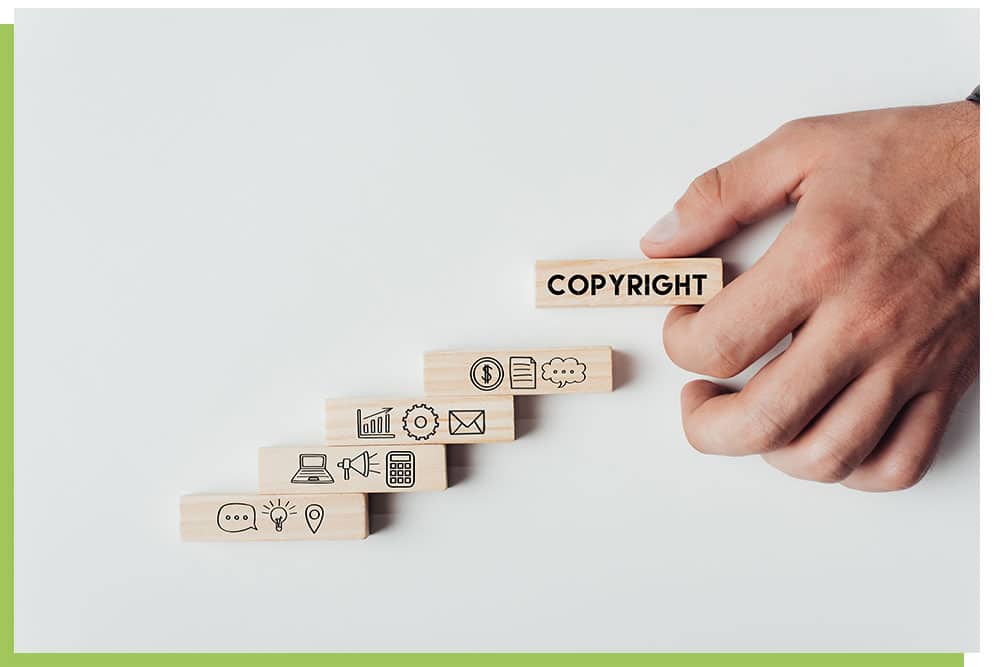- Mon - Fri: 10.00 - 17.00 EST
- Fort Lauderdale, Florida
- Send Message
Intellectual Property
- Home
- Intellectual Property
Intellectual Property Protection
Intellectual property (IP) can add enormous value to your company. Without the right protections and registrations, your company could be much less valuable and be vulnerable to potential copycats.

Common Assets
Trademarks
Brands spend over $200 million on logo design. Make sure you protect yours.
Patents
Patent-pending for $75?! A provisional patent application will save you time and money. Let's chat.
Copyrights
Fair use? Fixed in a tangible medium? Title 17 of the United States Code? Don't worry, we've got you covered.
Trade Secrets
Client lists, recipes, surveys, algorithms the list goes on...make sure your secrets are protected.
Non-Disclosure Agreements (NDAs)
Sharing confidential information is sometimes necessary to communicate your business case, technology, or collaborate on research and development. There are typically two types of NDAs, mutual (both parties sharing confidential information) and unilateral (one party sharing to the other, often in consulting services).
Confidentiality and Invention Assignment Agreements (CIAAs)
When contracting with engineers, developers, designers, or other co-founders, it is vital to ensure that the creations (content, renderings, designs, inventions, etc.), being created are owned by the client. That way, if there is any confusion as to who owns the rights to the IP, this agreement can make it clear where ownership lies.

“The one who does not protect the castle, will soon no longer have a castle.”
Wilborne law
Research and Database Searches
Getting started on researching whether IP protections exist on your desired protectees can be a daunting task. There are roughly 3 million active patents in the United States, with around 400,000 new patents granted the previous year. Roughly 800,000 trademarks were registered in the USPTO between 2003-2018.
The easiest place to start for beginners is just to run quick Google searches. In particular, patents.google.com is a fairly comprehensive database of world-wide patents, and is fairly easy to use. Additionally, reverse image searches can be a good start for finding copyrighted images, but can extend to more comprehensive searches on the Copyright Office’s websites. Trademark searches can vary from a simple google search as as a lowest baseline, transition to searches on the USPTO’s search engine TESS, or go all the way up to dedicated trademark search softwares for the most comprehensive of looks at the existing IP protections.
We can offer in-depth IP searches through use of the dedicated search softwares. We can compile all the information we find, organize it for you, and advise you on the probability of success on obtaining protection for your IP and what you can do to maximize your chances of success on doing so. Are your marks similar to another or too generic? We will let you know to minimize your headache dealing with registration processes and maximize your time growingn your business.

Registration
Trademarks: Trademarks must be registered with the USPTO. Some of the most common hurdles clients encounter when applying for a mark in the USPTO include but are not limited to (1) the mark is too confusingly similar to another mark with similar goods and services, (2) the mark is descriptive, (3) the applicant cannot properly classify or identify their goods and services, or (4) the applicant has not used the mark in commerce and is not sure when they intend to use the mark in commerce. Additionally, the USPTO operates on very strict deadlines that will result in abandonment of your mark if the deadlines are missed.
Patents: Patents, like trademarks, are also registered with the USPTO. Some of the most common hurdles clients encounter when applying for a patent in the USPTO include but are not limited to (1) the claimed invention is not novel, (2) the claimed invention is obvious, or (3) the description of the invention is considered inadequate.
Copyrights: A copyrightable work is an original work of authorship fixed in a tangible medium of expression. Copyrights must be registered with the Copyright Office. The application for copyright registration requires (1) a completed application form, (2) a nonrefundable filing fee, and (3) a nonreturnable deposit consisting of a copy or copies of the work being registered and deposited in the Copyright Office.
While trademarks and copyrights are not required to be registered with their corresponding offices to obtain basic protections, it is nonetheless recommended to register them, as registered IP offers better protection and easier enforcement.

Maintenance
Trademark: After a successful registration of your trademark, you must file: (1) a declaration of use or excusable nonuse between the 5th and 6th year following your registration date, (2) another declaration of use or excusable nonuse and an application of renewal between the 9th and 10th year following your registration date, and (3) file subsequent declarations of use or excusable nonuse and application for renewal every 10 years after that.
Patents: After a successful issuance of your patent, you must pay maintenance fees at regular intervals. The maintenance fee must be paid between 3-3.5 years, 7-7.5 years, and 11-11.5 years after the date of issue.
Patents: After a successful issuance of your patent, you must pay maintenance fees at regular intervals. The maintenance fee must be paid between 3-3.5 years, 7-7.5 years, and 11-11.5 years after the date of issue.
Trade Secrets: To maintain your trade secrets, you must ensure that (1) it is indeed a secret, (2) the secret confers competitive advantage on its owner, and (3) you continuously subject the secret to reasonable effortws to maintain its secrecy.

Enforcement
Trademarks: How you enforce your trademarks depends on where the infringing mark is in its lifecycle. If someone is applying for a mark you believe will infringe on your rights, you may open up an opposition with the Trademark Trial and Appeal Board when the infringing mark is published for opposition in the Trademark Gazette. Alternatively, if the infringing mark is already in use, you may choose to send a cease and desist, notifying them of your rights. In the scenario which the infringing mark continues to be used, you may consider bringing a federal action under 15 U.S.C. 1114 in the proper district court for trademark infringement.
Patents: Similar to trademark infringements, there are also a variety of methods of dealing with patent infringers. One such way is to challenge the validity of the infringer’s patent through Inter Partes Review (IPR) with the Patent Trial and Appeal Board. A federal action may also be brought under 35 U.S.C. 271 in the proper district court for patent infringement.
Copyrights: Owners of a registered copyright may bring a federal action in the proper district court for copyright infringement under the Copyright Act and 17 U.S.C. 501.
Trade Secrets: Owners of a misappropriated trade secret may bring a federal claim in the proper district court for trademark misappropriation under the Defend Trade Secrets Act of 2016 (DTSA).
There are numerous ways to protect and enforce your IP. We can advise you of the proper steps to take when these situations arise.

Licensing and IP Sale
Wilborne Law assists clients in selling and licensing IP rights. Further, we help you negotiate favorable terms for acquiring rights from other parties. We have experience with drafting and structuring licensing deals for brands, software, and technology. We also provide website terms of services and privacy policies. We help out clients extract maximum value from the IP while minimizing risk of lawsuits and infringement.
Intellectual Property FAQ
Can't I simply use samples from online?
- Already existing IP registrations are a great way to educate yourself on commonly used language and terms, particularly for your creation/industry. However, without an attorney reviewing your material, it is unlikely to address your specific circumstances and address your specific needs.
- We will not only help with the research process, but craft language that is favorable to protect your IP for your specific business model. .
How much are the intellectual property costs?
We work on a combination of flat fees and hourly (depending on the research required).
How do I know what type of intellectual property protection I need?
This can vary based on a myriad of factors including what the IP is, how you intend to use, how you intend to monetize it, and your desired business goal. For instance, some people need a patent on the way their software communicates and the business process behind it, whiles other rely on trade secret law and keep their material confidential at all times. Others implement a combination of open source and restricted licenses, which require additional nuances. It all depends on your circumstances.
I'd like to give the research databases a shot. Where do I start?
Patents:
USPTO: http://patft.uspto.gov/netahtml/PTO/search-bool.html
Trademarks:
Justia: https://trademarks.justia.com/
USPTO: https://tsdr.uspto.gov/ (for more detailed looks at the application process of problematic marks)
Copyrights:
Copyright Office: https://cocatalog.loc.gov/cgi-bin/Pwebrecon.cgi?DB=local&PAGE=First
Testimonials


